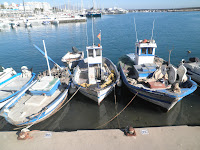A spot on the Costa del Sol that remains delightfully Spanish - Estepona
Estepona sits on the western side of the Costa del Sol at the foot of the Sierra Bermeja mountains. Under a clear blue sky the rock of Gibraltar stands solid further to the west and across a narrowing stretch of sea lies the coast of Africa. The sight of another continent, almost within touching distance, stirs the wanderlust in me whilst the white-washed buildings of Andalucían towns such as Estepona make me want to stay put.
As a compromise I wandered the long promenade that abuts Estepona's clean golden beaches, stared out towards Africa and planned my next trip (which bizarrely, demonstrating the fickleness of my mind, will be nowhere near Africa). My wanderings took me away from the port, which unlike its ostentatious neighbour Puerto Banús gives mooring space to the small fishing boats that I watch coming back to port of a morning as well as the more pricey and flashy boats of the well-heeled, and towards the main part of the town.
The main shopping street is populated with the usual fare of phone shops, clothing franchises and shoe emporium but as it tails out into the Calle Real the old-fashioned Spanish-ness is still very much in evidence. A street vendor sells the prickly pear fruits that are so painful to harvest unless one is properly equipped with very thick gloves whilst a green-grocer's shop rests produce on plastic crates outside its door - no fuss, no flair, the produce sells itself.


The old town climbs the gentle hill with narrow streets of white-washed buildings. Some of the streets and the little plazas that open up out from them, such as Calle San Antonio and the Plaza de Manilva, have been restored in recent years but retain their old charm. We stumbled across Longman's Librería (bookshop) in Plaza de Manilva and unable to resist the call of the printed word entered. I want a little shop like this selling used and new books, stacked with books from Dostoyevsky to Cornwell (that's quite a spread) and with a selection of French, Spanish and German language books as well. We informed the ladies that we were off to see the Three Kings distributing sweets to the town's children at 1.30 at the Town Hall. They were surprised as it is usually at around 5pm. We headed up to the Ayuntamiento regardless.
Down the hill from the town hall is the municipal market. An indoor affair, the road outside the building was being renovated; we entered through the rear entrance of the market which nestles against the ruins of the Castillo San Luis which had been built during the early part of the 16th century to replace an old Arab fortification called the Estebbuna (from which it is thought the name Estepona derives). The market was quiet as it neared the end of the working day for the stall-holders with a few women carrying out their shopping. It is reminiscent of the markets in England (that I recall from the 1970s that seemed to die out as the progress of the 1980s took hold). Fishmongers, butchers, bakers, sweet-sellers, you can get all your food under one roof, just like a supermarket, but fresher.
 Doubling back we passed the pastel pink clock tower and carried on towards the Iglesia de Santa María de los Remedios. On a previous visit the church doors had been open and after a quick look at the statue of Don Manuel, a former priest of the church, I had entered to see a huge belen (nativity) being constructed. I had hoped to see the finished article but this day the doors remained firmly shut. I am becoming increasingly frustrated at being thwarted in entering churches - they should be open during all daylight hours in my opinion. We stepped down some floral decorated lanes towards the Plaza de Flores.
Doubling back we passed the pastel pink clock tower and carried on towards the Iglesia de Santa María de los Remedios. On a previous visit the church doors had been open and after a quick look at the statue of Don Manuel, a former priest of the church, I had entered to see a huge belen (nativity) being constructed. I had hoped to see the finished article but this day the doors remained firmly shut. I am becoming increasingly frustrated at being thwarted in entering churches - they should be open during all daylight hours in my opinion. We stepped down some floral decorated lanes towards the Plaza de Flores. 
The centre of the square, around the fountain, was filling with tables and people taking coffee or lunch. The trees were decorated with brightly wrapped presents off which the sun glinted. The tower of the church rose in the background. The predominant language that filled the air was Spanish, as it had been all day. Numerous nationalities live in Estepona, and are catered for with the bookshop one example along with the various bars in the port, but it has remained resolutely Spanish and this is what makes the town of Estepona such a pleasure to visit.
I visited Estepona on the 5th January 2013.












I love Estepona, it really it a piece of traditional Spain on the beach, but whats better is that it has had a lot of money spent on it recently modernizing facilities etc. There is not a lot of good area information on Estepona so thank you for this. I will be sure to check it out when im on the Costa del Sol next...
ReplyDelete